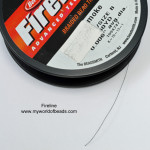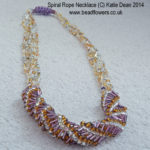Bugle Beads
It could be argued that Bugle beads are some of the oldest ‘shaped seed beads’ around. I have classified them as seed beads since they fit into the sizing pat tern that means they can be used alongside all the other seed bead varieties we have on the market.
tern that means they can be used alongside all the other seed bead varieties we have on the market.
In this blog, I want to start by showing you bugle beads, talking a bit about how to use them and then giving you some links to patterns to get you started. You may not have known their name before, but I feel pretty sure you will recognise what Bugle Beads look like!
What are bugle beads?
Bugle beads are narrow canes of glass. They come in all sorts of different sizes, but the size refers to the length of the cane, rather than width. To the best of my knowledge, bugle beads are a standard width (I’m talking about the hole size here) and that is, approximately equal to a size 11 seed bead. If you like precision measurements, then this is about 1-2mm. As with other seed beads, there is a sizing system and that reflects the length of the tube. If you know anything at all about beads, then it probably won’t surprise you to know that the sizing system varies from one manufacturer to another!
 So, in terms of manufacturers: the three big Japanese companies, Matsuno, Miyuki and Toho, all make bugle beads. The only manufacturer in the Czech Republic is Preciosa. I found this handy table with a guide to sizing and conversions between manufacturers. By all means keep it and use it as a reference, but I also issue a word of caution. If you are working with a pattern that specifies a particular brand of Bugle, do keep to that brand since you may find the sizing doesn’t quite work out if you try and swap! It’s basically the same rule as other seed bead brands, which I covered in this post earlier this year. For some patterns this will not matter, but if you are trying to mix different colours within a project do also make sure you keep to the same brand or you will find yourself working with just very slightly different lengths.
So, in terms of manufacturers: the three big Japanese companies, Matsuno, Miyuki and Toho, all make bugle beads. The only manufacturer in the Czech Republic is Preciosa. I found this handy table with a guide to sizing and conversions between manufacturers. By all means keep it and use it as a reference, but I also issue a word of caution. If you are working with a pattern that specifies a particular brand of Bugle, do keep to that brand since you may find the sizing doesn’t quite work out if you try and swap! It’s basically the same rule as other seed bead brands, which I covered in this post earlier this year. For some patterns this will not matter, but if you are trying to mix different colours within a project do also make sure you keep to the same brand or you will find yourself working with just very slightly different lengths.
How to Use Bugle Beads
I understand that Bugle beads first appeared in the 1860s and were commonly used to  decorate dresses and evening bags. In fact, as you looked at them, you may have thought immediately of intricate bead embroidery. Their shape makes them perfect for adding to create fern-like decoration in a floral motif. If you bead them side by side, you get a lovely textured surface. Depending on the finish you use, this will bounce around light to add some beautiful effects.
decorate dresses and evening bags. In fact, as you looked at them, you may have thought immediately of intricate bead embroidery. Their shape makes them perfect for adding to create fern-like decoration in a floral motif. If you bead them side by side, you get a lovely textured surface. Depending on the finish you use, this will bounce around light to add some beautiful effects.
You may also be familiar with seed beads used as fringing. You often see them used to add a fringe to a pendant or pair of earrings. I particularly think of this in association with Native American styles. Like all good seed beads, Bugle beads can be used in a  number of bead-weaving techniques as well. They are particularly effective in netting. I think of them for Russian Spiral technique (this is really a variation of netting) and they can work in Right Angle Weave. I have also used them in Ladder stitch and this made a basis from which to work a brick stitch section, as you can see in my daisy bracelet.
number of bead-weaving techniques as well. They are particularly effective in netting. I think of them for Russian Spiral technique (this is really a variation of netting) and they can work in Right Angle Weave. I have also used them in Ladder stitch and this made a basis from which to work a brick stitch section, as you can see in my daisy bracelet.
You will struggle to use them for Peyote or Brick stitch, but you can of course always add them as an embellishment.
The Pitfalls of Bugle Beads
All beads have a few disadvantages that you should know about so you can work around them. To my mind, the biggest disadvantage with bugle beads is that they can cut beading thread. I believe the beads are made by blowing a long, long tube of glass which is then precision cut into the desired lengths. Sometimes, the cutting process results in a cut that is at an angle. These are really likely to cut through thread, I have found.  So you want to check that your bugle beads have lovely straight ends to them. Even with this, there is still a danger that the glass edge is a little sharp. So I always recommend using Fireline when you are working with Bugle beads.
So you want to check that your bugle beads have lovely straight ends to them. Even with this, there is still a danger that the glass edge is a little sharp. So I always recommend using Fireline when you are working with Bugle beads.
Having said that, I began by saying that Bugle beads were created for use in bead embroidery. I do find that because you are anchoring the beads onto the material, there is less tendency for the sharp edges to rub against the thread and break it. I’m not saying this doesn’t happen, but I personally do not use Fireline for bead embroidery because I prefer the feel of the nylon based threads that are a little more like sewing cotton. So, I always use my thread double in any case and, I would recommend stitching through each bead twice when it is a Bugle bead. I think there’s less chance of the sharp edge cutting through four pieces of thread than just one or two!
Bugle Bead Varieties
I have mentioned length and colour, but there is  another variation on the bugle bead. You can get twisted bugles. As the name suggests, the cane of glass has simply been twisted into a spiral as it was made. The effect is really beautiful and, due to the twisting, the light bounces off these bugle beads in different ways. So you can use this to great effect to create patterns and clever illusions in your work. I fell in love with the twisted bugle beads when I made my shooting star beaded ornament. I used the bugles for the fringe and the twisted effect really creates some interesting light illusions as the decoration hangs on my Christmas tree.
another variation on the bugle bead. You can get twisted bugles. As the name suggests, the cane of glass has simply been twisted into a spiral as it was made. The effect is really beautiful and, due to the twisting, the light bounces off these bugle beads in different ways. So you can use this to great effect to create patterns and clever illusions in your work. I fell in love with the twisted bugle beads when I made my shooting star beaded ornament. I used the bugles for the fringe and the twisted effect really creates some interesting light illusions as the decoration hangs on my Christmas tree.
Patterns Using Bugle beads
That seems like a good place to move on to sharing some pattern ideas with you. Keeping with the Christmas theme, how about a beaded angel? The bugle beads make a delightful skirt for her.
I created a simple pair of earrings using Bugle Beads and netting when I wrote the ‘Focus on Netting’ booklet to accompany this website. You can get it here. Keeping to the theme of netting, if you want to try a Russian spiral with bugle beads, then this rope necklace is the pattern for you!
I have also used bugle beads to embellish my beadwork. In the chocolate gateau cake that you can find in Sweet Treats, or the chocolate gateau slice, I used bugles to look like chocolate sprinkles! I used long bugles to create fins for my fish, since they gave a beautiful texture. You can find that pattern here. I also mixed them with various sized seed beads in a bead embroidered bauble.
So, I hope that gives you a few ideas and, with any luck, the chance to fall in love with bugle beads.


















What thread work better for bugle seed beads because everytime use wildfire thread the bugle seed bead rip the thread in half with ever bugle Projects
Usually, I would recommend this thread, or Fireline. If you are having trouble with the beads tearing it, you might want to try adding some size 15 seed beads at the top and bottom of each bugle so the thread isn’t directly in contact with the edge of the bead. Or, have you seen the new Tubelet beads? They are a new substitute for Bugles, but with rounded ends to solve the problem of tearing thread. I just blogged about them here: Tubelet Beads
Hi, can I use bugle beads on kumihimo?
In theory, you would thread the bugles and use them like any other beads. But I’ve never seen them used this way. You could use them to add a fringe at the end. That might be an idea to think about. I think they might just be the wrong shape for use within a beaded Kumihimo rope.
I need to sew straight lines of bugle beads onto a dress, what is the best technique for doing this?
The best technique for this would be a bead embroidery technique – you could either use couching or use back-stitch. Both are explained in detail in the bead embroidery section on here: https://www.myworldofbeads.com/category/learn-bead-embroidery/